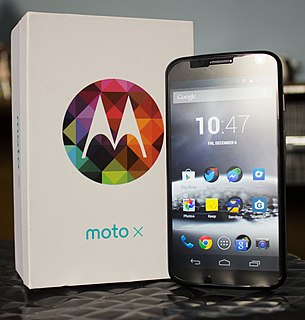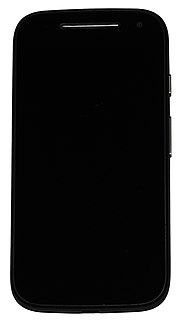Motorola Mobility LLC, marketed as Motorola, is an American consumer electronics and telecommunications company, and a subsidiary of Chinese multinational technology company Lenovo. Motorola primarily manufactures smartphones and other mobile devices running the Android operating system developed by Google.
Motorola Moto is a range of Android mobile devices manufactured by Motorola Mobility, a subsidiary of Lenovo. The Moto brand is also used and marketed for certain public-safety products from Motorola Solutions and by Motorola brand licensees on certain home products and mobile accessories.

A smartwatch is a wearable computer in the form of a watch; modern smartwatches provide a local touchscreen interface for daily use, while an associated smartphone app provides for management and telemetry. While early models could perform basic tasks, such as calculations, digital time telling, translations, and game-playing, 2010s smartwatches have more general functionality closer to smartphones, including mobile apps, a mobile operating system and WiFi/Bluetooth connectivity. Some smartwatches function as portable media players, with FM radio and playback of digital audio and video files via a Bluetooth headset. Some models, called watch phones, have mobile cellular functionality like making calls.

The Sony SmartWatch is a line of wearable devices developed and marketed by Sony Mobile that connect to Android smartphones and can display Twitter feeds and SMS, among other things. Different versions are compatible with different Android devices.

Moto X is an Android smartphone developed and manufactured by Motorola Mobility, and released in August 2013.

The Moto G is an Android smartphone developed and manufactured by Motorola Mobility, at the time a subsidiary of Google. Released on 13 November 2013, the phone was initially aimed at emerging markets, although it was also available in developed markets as a low-price option.

Wear OS is a version of Google's Android operating system designed for smartwatches and other wearables. By pairing with mobile phones running Android version 6.0 or newer, or iOS version 10.0 or newer with limited support from Google's pairing application, Wear OS integrates Google Assistant technology and mobile notifications into a smartwatch form factor.

The Moto 360 is an Android Wear-based smartwatch announced by Motorola Mobility in 2014. It was announced on March 18, 2014 and was released on September 5, 2014 in the US along with new models of the Moto X and the Moto G.
Android One is a family of third-party Android smartphones promoted by Google. In comparison to many third-party Android devices, which ship with a manufacturer's customized user interface and bundled apps, these devices run near-stock versions of Android with limited modifications, and a focus on Google services. Android One devices receive OS updates for at least two years after their release, and security patches for at least three years.

The second generation Moto X, marketed as moto X and referred to in the media as Moto X (2014), is an Android smartphone developed by Motorola Mobility. Released on September 5, 2014, it is the successor to the original Moto X released in 2013. It was succeeded by the third generation Moto X Style and Play family, announced on July 29, 2015.

The second-generation Moto G is an Android smartphone developed by Motorola Mobility. Released on September 6, 2014, it is a successor to the original Moto G released in 2013. The phone was initially aimed at developing markets, although it is also available in developed markets as a lower-cost option compared to other phones in its class.

Microsoft Band was a smart band with smartwatch and activity tracker/fitness tracker features, created and developed by Microsoft. It was announced on October 29, 2014. The Microsoft Band incorporated fitness tracking and health-oriented capabilities and integrated with Windows Phone, iOS, and Android smartphones through a Bluetooth connection. On October 3, 2016, Microsoft stopped sales and development of the line of devices. On May 31, 2019, the Band's companion app was decommissioned, and Microsoft offered a refund for customers who were lifelong active platform users.

The second generation Moto E is an Android smartphone developed by Motorola Mobility. Released on February 25, 2015, it is a successor to the Moto E released in 2014. The New Moto E is a low-end device for first-time smartphone owners or budget-minded consumers, and is available in 40 countries worldwide.

The third-generation Moto G is an Android smartphone developed by Lenovo's subsidiary Motorola Mobility, unveiled in India on July 28, 2015 and released the same day. The Moto G4 is its successor.

Moto X Play is an Android smartphone developed by Motorola Mobility, a subsidiary of Lenovo. Unveiled on July 28, 2015, it was one of three devices that succeeded the second-generation Moto X. In contrast to the high-end Moto X Style, the Play is a mid-range device distinguished by its high battery capacity.

The Huawei Watch is an Android Wear-based smartwatch developed by Huawei. It was announced at 2015 Mobile World Congress on March 1, 2015, and was released at Internationale Funkausstellung Berlin on September 2, 2015. It is the first smartwatch produced by Huawei.

Moto Z is an Android smartphone developed by Motorola Mobility. Unveiled on June 9, 2016, as its flagship model for the year, the Moto Z is distinguished by the "Moto Mods" ecosystem which allows case accessories to be magnetically attached to the device to provide additional functionality. The Moto Z was later joined by the more rugged Moto Z Force of which shares most of the same internals as the former, and the mid-range Moto Z Play with downgraded specifications, all three devices being compatible with the modular system.
The Moto E3 and the Moto E3 Power are Android smartphones developed by Motorola Mobility, a subsidiary of Lenovo. These phones make up the third generation of the low-end Motorola Moto E series. The E3 was released in July 2016. The E3 Power was released through Flipkart in India in September 2016, and sold a record 100,000 units on its first day of sale.

Moto G5 is a series of Android smartphones developed by Motorola Mobility, a subsidiary of Lenovo. It is the fifth generation of the Moto G family. Announced as successors to the Moto G4, they were first released in March 2017 in several markets including India and Europe. The original variants are the Moto G5 and Moto G5 Plus, the latter also being available as an Amazon Prime version in the United States. Special editions called Moto G5s and Moto G5s Plus were first released in August 2017.
Moto X4 is an Android smartphone developed by Motorola Mobility, a subsidiary of Lenovo. Unveiled on August 31, 2017, at IFA, it is a revival of the previously discontinued Moto X line. It was released in Europe at the end of September 2017.














